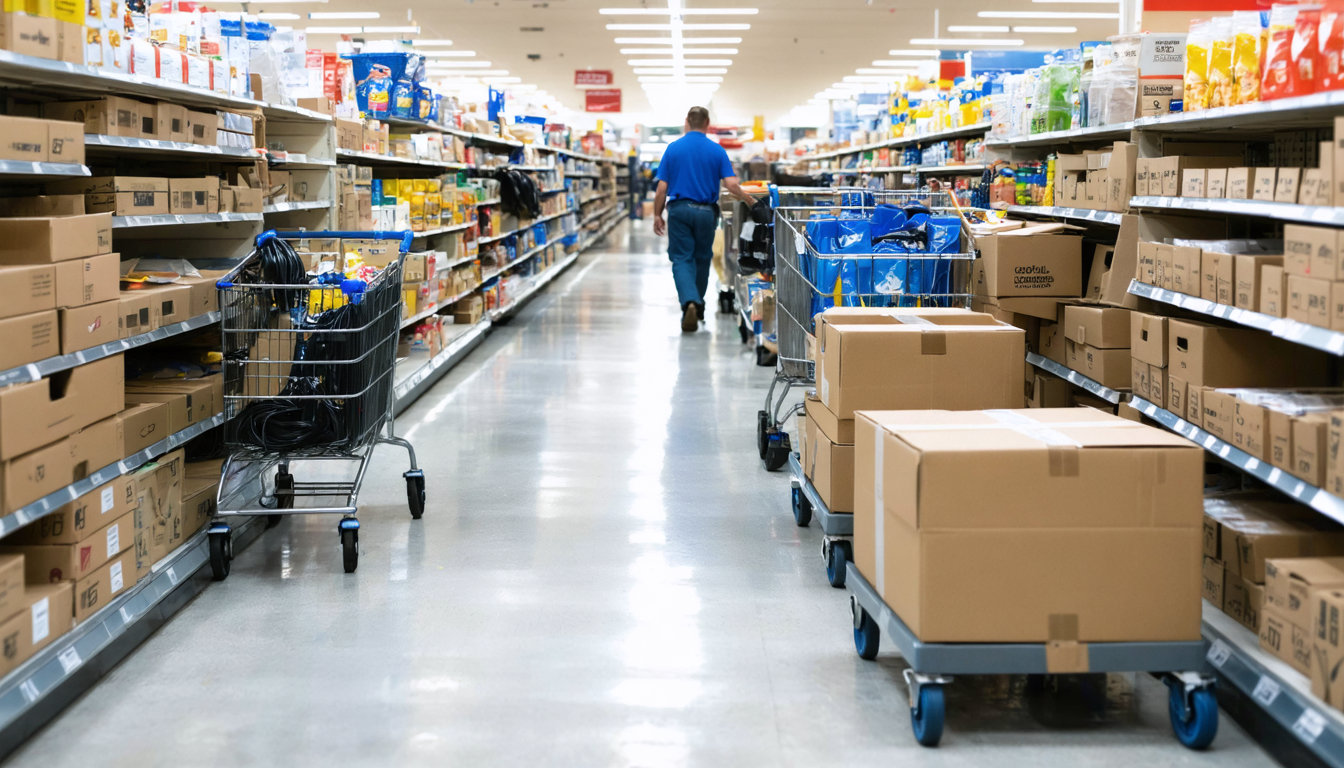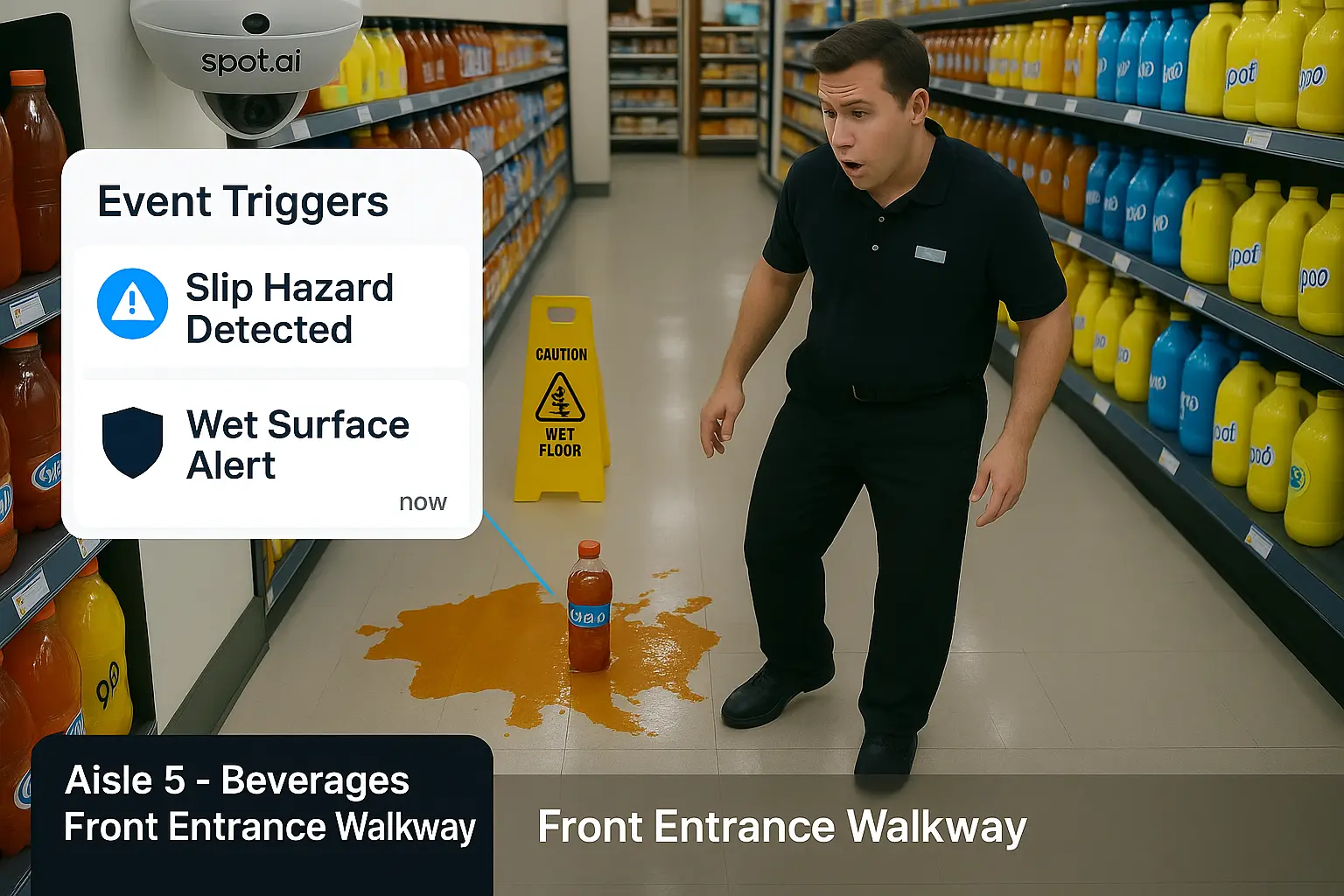Each year, slips, trips, and falls (STF) rack up nearly $10 billion in direct costs for U.S. retailers—making these incidents the second most disabling workplace injury in the sector (Source: Liberty Mutual Workplace Safety Index, 2025).
But here’s the good news: most STF injuries can be prevented. By combining proven safety protocols with real-time video intelligence, retailers can move from chasing down incident reports to stopping accidents before they start. This guide breaks down the true costs, root causes, and gives you a practical framework for evolving from a reactive to a proactive safety model using modern technology.
Why Slips, Trips, and Falls Are a Major Risk for Retailers
Slips, trips, and falls aren’t just a backroom issue—they happen everywhere from high-traffic entrances to crowded stockrooms. The scale of the problem is hard to ignore: STF incidents make up 12.5% of all workplace injuries in retail, with store aisles, parking lots, and stockrooms topping the list of risk zones (Source: BLS Injury Data, 2025).
But beyond the numbers, every incident means lost time, administrative headaches, and potential OSHA penalties. The average penalty for a retail STF incident sits at $7,705, with some cases exceeding $100,000 (Source: OSHA Data, 2025).
The Top 5 Causes of Slips, Trips, and Falls in Retail—and How to Prevent Them
Understanding why these incidents happen is the first step to stopping them. Here are the five leading causes of STF accidents in retail, with practical prevention strategies and how AI-driven video analytics can take your safety program to the next level.
1. Wet or Slippery Surfaces

The Hazard:
On a stormy afternoon, a customer enters a grocery store, tracking rainwater across the tile floor near the entrance. Minutes later, an employee slips in the puddle while restocking a nearby display, injuring their hip—a body part frequently impacted in these falls.
Traditional Prevention:
Posting “Wet Floor” signs and absorbent mats at all entrances.
Immediate cleanup protocols for spills and tracked-in moisture.
Regular inspection of high-traffic areas during inclement weather.
How AI Amplifies Prevention:
AI-powered video analytics can instantly detect when someone falls or moves erratically (“possible fall” events) and alert safety teams in real time. Over time, these systems highlight high-risk locations and times, allowing teams to adjust cleaning schedules or deploy mats precisely when and where they’re needed.
2. Cluttered Walkways and Tripping Hazards

The Hazard:
During a busy weekend sale, restocking carts, display boxes, and electrical cords accumulate in the main aisle. An employee carrying inventory trips over a stray cord, fracturing their ankle—one of the top five injury sites in retail STF incidents.
Traditional Prevention:
Regular housekeeping sweeps to keep aisles clear.
Using cable covers and securing cords.
Training staff to store merchandise and equipment safely.
How AI Amplifies Prevention:
Video analytics can monitor for crowding and obstructions, alerting staff to blocked walkways before someone gets hurt. Reviewing flagged incidents makes it easy to spot trouble spots and update protocols for better compliance.
3. Poor Lighting and Visibility
The Hazard:
A stock clerk heads into a dimly lit storage room after closing. Missing a step on the uneven floor, they trip and fall, injuring their knee. Poor lighting is a hidden danger in stairwells, parking lots, and storage areas (Source: Retail Industry Reports, 2025).
Traditional Prevention:
Scheduled checks and prompt replacement of bulbs.
Installation of motion-activated or brighter lighting in critical areas.
Use of high-visibility tape to mark steps and elevation changes.
How AI Amplifies Prevention:
Video analytics can flag “running” or erratic movement in poorly lit areas, often a sign of someone trying to navigate hazards. These insights help facilities teams prioritize lighting upgrades and maintenance, while footage clarifies if visibility contributed to an incident.
4. Unsafe Behaviors: Rushing and Distraction
The Hazard:
At shift change, a cashier rushes to clock out, glancing at their phone and not noticing a freshly mopped section. They slip, sustaining a leg injury. Time pressure and distraction are leading behavioral factors in STF incidents (Source: Retail Industry Reports, 2025).
Traditional Prevention:
Visible reminders and signage to “walk, don’t run.”
Safety briefings on the dangers of multitasking and rushing.
Staff supervision during peak traffic periods.
How AI Amplifies Prevention:
AI analytics detect “running” or sudden movement in aisles and corridors, acting as an early warning for unsafe behaviors. Reviewing these alerts helps managers target training and reinforce safe habits during high-risk times.
5. Stairs, Ladders, and Elevation Changes
The Hazard:
A stock associate uses a step stool to retrieve an item from a top shelf. The stool has a worn tread, and as they reach, the stool slips, causing a fall and a fractured ankle. Falls from ladders and stairs—even from under 6 feet—are a significant source of serious injury in retail.
Traditional Prevention:
Regular inspection and maintenance of stairs, ladders, and handrails.
Training employees on safe ladder use and the “three points of contact” rule.
Marking elevation changes and ensuring proper equipment is always available.
How AI Amplifies Prevention:
AI video systems can detect “possible fall” events on stairs and in stockrooms, as well as monitor for unsafe ladder use. Real-time alerts speed up response and enable thorough root cause analysis, supporting retraining and future prevention.
Integrating a Modern AI Camera System: From NVR to AI Insights in Retail
Upgrading your safety tech doesn’t mean scrapping what you have. Modern AI camera systems are designed to work with your existing infrastructure—including the standard POE cameras already in many stores. No expensive “rip-and-replace” needed. Instead, a smart analysis layer connects your current cameras to a secure, cloud-native dashboard.
Here’s how it compares:
Feature | Traditional NVR System | Modern AI Video Platform |
|---|---|---|
Camera Compatibility | Requires new/specific models | Works with existing POE/legacy cams |
Storage | On-premise hardware | Secure, cloud-native, scalable |
Maintenance | Frequent, on-site | Minimal, remote updates |
User Access | Limited seats | Unlimited users, unified dashboard |
Video Review | Manual, slow | AI-powered search & incident detection |
Insights | Passive footage | Real-time alerts for falls, running, crowding |
A cloud-based AI camera system bridges legacy cameras to a unified dashboard—no bulky servers or limited access. It automates incident detection, reduces investigation time by up to 95%, and empowers unlimited staff to monitor and act on safety issues.
Unlike standard NVRs, the AI layer surfaces actionable insights—flagging possible falls, running, and crowding—so your team can respond proactively, not just react to incidents.
Tips for Retailers Considering AI Camera Upgrades:
Prioritize solutions that support your existing safety policies and compliance with OSHA 29 CFR 1910.22 (walking-working surfaces).
Ensure compatibility with your current camera infrastructure—look for platforms that accept both modern and legacy feeds.
Choose systems that offer real-time insights and unlimited user access, breaking down silos between safety, operations, and IT.
Align technology upgrades with broader safety goals—integrate with incident reporting, training, and regular safety audits.
Transform Retail Safety—Book a Safety Consultation
Every slip, trip, or fall is a chance to improve—not just to respond. By integrating AI-driven video analytics with your existing protocols, you can dramatically reduce risk, speed up investigations, and make sure every member of your team and every customer feels safe.
Ready to see how video intelligence can empower your safety program and prevent the next incident? Book a safety consultation with Spot AI’s experts for tailored, actionable guidance.
Frequently asked questions
What are the main causes of slips, trips, and falls in retail?
The primary causes are wet or slippery surfaces, cluttered walkways, poor lighting, unsafe behaviors like running or distraction, and injuries on stairs, ladders, or after elevation changes (Source: OSHA Data, 2025).
How can retail organizations implement safety technology without disrupting operations?
Modern AI video platforms connect directly to your existing cameras, overlaying analytics without interrupting daily operations. They automate hazard detection and reporting, supporting your staff rather than replacing them.
Are there compliance standards for slip, trip, and fall prevention in retail?
Yes. OSHA 29 CFR 1910.22 requires retailers to keep all walking-working surfaces clean, orderly, and free from hazards. Regular safety audits and staff training are also considered best practice (Source: OSHA, 2025).
What practical steps should retailers take before adopting AI camera technology?
Start with a safety risk assessment—identify high-traffic zones and current camera coverage. Involve your IT, safety, and operations teams early. Pilot the system in a problem area, review results, then expand based on data-driven improvements.
How does AI video analytics help with incident investigations?
AI-powered video platforms automatically flag incidents—such as possible falls or crowding—making it easy to review footage, understand root causes, and support faster, more accurate investigations for compliance and insurance.
How can safety technology help reduce stress for safety managers?
AI-driven analytics automate hazard detection, freeing safety managers from endless manual monitoring and reporting. This enables a shift from reactive tasks to proactive planning and team support.
About the author
Joshua Foster
IT Systems Engineer, Spot AI
Joshua Foster is an IT Systems Engineer at Spot AI, where he focuses on designing and securing scalable enterprise networks, managing cloud-integrated infrastructure, and automating system workflows to enhance operational efficiency. He is passionate about cross-functional collaboration and takes pride in delivering robust technical solutions that empower both the Spot AI team and its customers.

























.png)
.png)
.png)